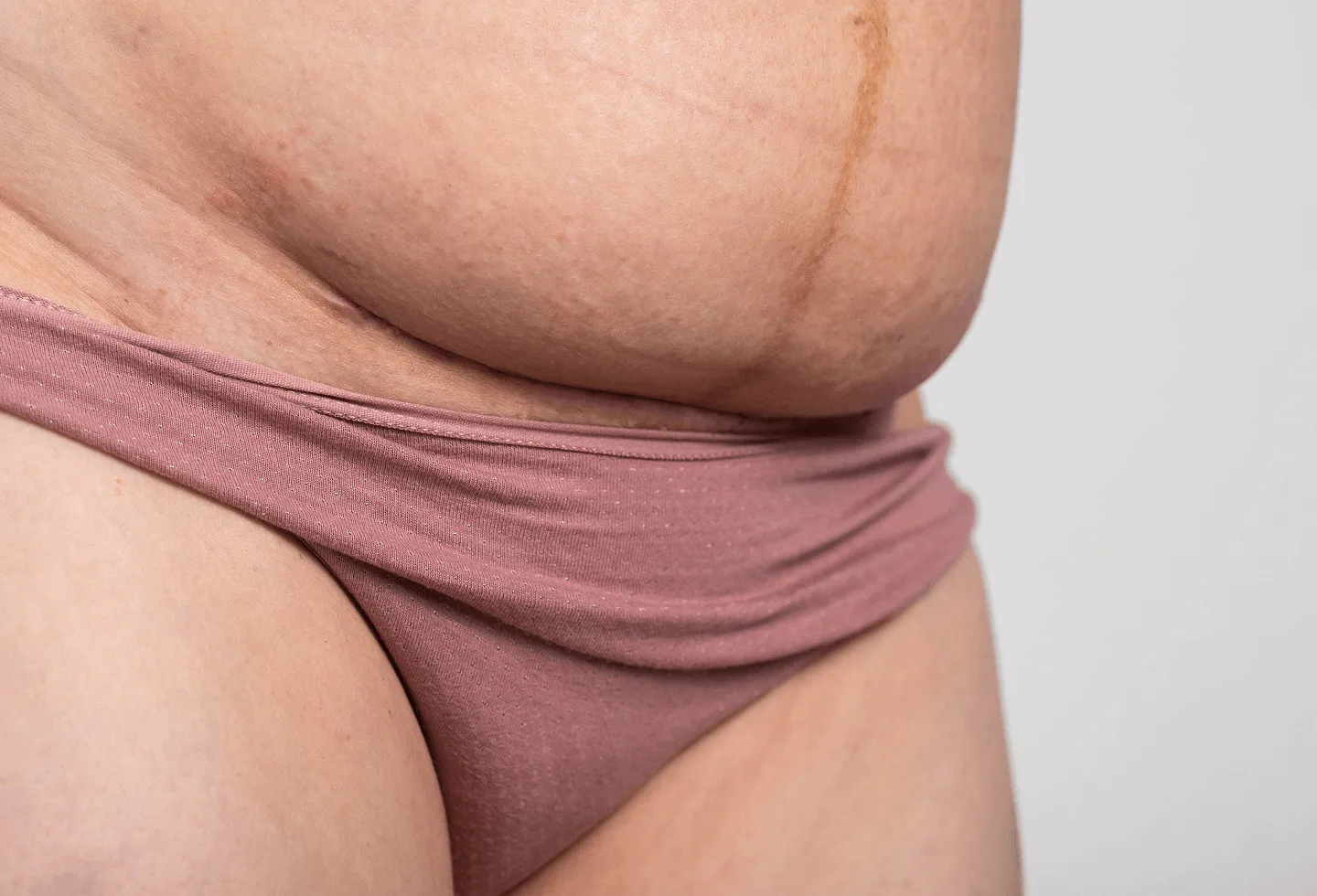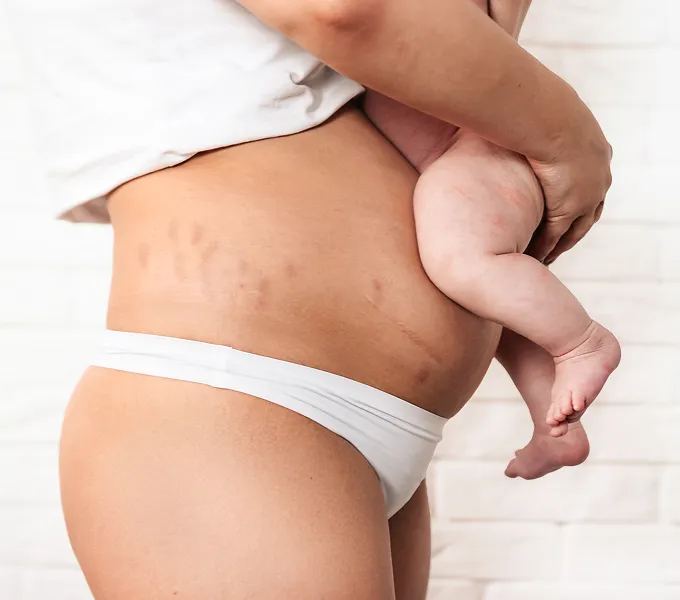
Everything You Need to Know About The C-Section Shelf
Clinically reviewed by Liz Miracle, PT, MSPT, WCS.
One out of every three people will give birth via cesarean section (commonly referred to as c-section) each year making it one of the most common surgeries. But just because it's a common surgery does not make it an easy one, especially when it comes to the recovery process.
During a c-section, the surgeon cuts through 7 different layers of tissue, a process that has a deep impact on your body that can extend beyond the ab muscles. Common concerns that can linger after a cesarean section include scar tissue adhesion (or bands of scar tissue that stick to other tissues or organs), which can contribute to complications such as bowel obstruction, pelvic pain, and secondary infertility. Cesarean scar syndrome is also a complication that can result from the surgery, causing various issues including pelvic pain, pain during sex, bleeding, and menstrual changes.
What is a C-Section Shelf?
Another common effect of a c-section is a c-section shelf, aka a "c-section pooch," or "overhang," which refers to a bulge or shelf-like appearance above the c-section scar. Besides the strain this can place on someone's self-esteem or body confidence, it can also contribute to physical symptoms and pain. But you don't have to just deal with it – thankfully, there are several ways to help a c-section shelf. Physical therapy interventions (like those offered at Origin) are a great place to start.
A c-section shelf refers to the "shelf-like" appearance of the skin area around a cesarean section scar.
What Causes a C-Section Shelf?
Although there are several possible causes, it is often caused by deep abdominal scar tissue that can cause the skin to hang or "pooch" out over the scar as the tissue heals.
- Scar Tissue Formation: After a c-section surgery, it’s not uncommon for deep abdominal scar tissue to accumulate that can cause pain, restricted movement, or adhesions. This scar tissue and adhesions can contribute to the shelf-like appearance around the scar.
- Fat Accumulation: It's also common for fat to accumulate in the lower abdomen area following a c-section surgery. This can enhance the appearance or prominence of the shelf.
- Skin Elasticity: After pregnancy, changes in skin elasticity can occur due to hormones, stretching, and other normal changes that occur during pregnancy. All of these factors can contribute to the development of a c-section shelf.
- Diastasis Recti: Diastasis recti or abdominal separation, is when the connective tissue between your rectus abdominis muscles become overstretched. This can affect the appearance of a c-section shelf since abdominal muscle dysfunction from diastasis plays a role in how you heal from a c-section.
How Can Physical Therapy Help My C-Section Shelf?
A specialized pelvic floor physical therapist can help you navigate each stage of your postpartum care journey from the moment you leave the hospital with your baby. Physical therapy can help you recover from birth and navigate the c-section shelf, diastasis recti, or other issues such as exercise, pelvic pain, pelvic floor issues, and more. Below are several of the ways a physical therapist may help you with a c-section shelf. Always be sure to clear any of these methods with a medical provider and with your physical therapist before trying them at home.
1. Scar Tissue Mobilization:
One method for improving the c-section shelf is via manual massage and myofascial release, or manually manipulating the scar and surrounding area with the aim to improve scar mobility. Improving scar mobility can help reduce adhesions, and help enhance the appearance of the scar and c-section shelf. "Massaging or mobilizing the scar can help improve the flexibility and mobility of the scar by improving the tissue restrictions caused by the underlying scar tissue," says Dr. Sarah Clampett, a physical therapist and Head of Virtual Clinical care Origin. "In most cases, improving the mobility and flexibility of the scar will also enhance the overall appearance of the scar as it begins to move more like the surrounding skin and tissues."
2. Core Strengthening Exercises:
Strengthening the deep core muscles with gentle exercises targeting the transverse abdominis and pelvic floor muscles can help reduce the shelf's prominence and support overall core strength and stability. "Whenever a patient is healing from a cesarean birth, abdominal and pelvic floor exercises are paramount for healing. Exercises that target the transverse abdominis and pelvic floor, like abdominal bracing, bent knee fall outs, and marches help to strengthen the deep core muscles and can help tighten the overall appearance of the belly as the muscles get stronger," says Dr. Clampett. Your core is also essential for supporting good posture, and that can help take stress off of your low back, hips, and upper body, according to Dr. Clampett.
"Exercises like cat/cow, open books, or lower trunk rotations can also help to improve the overall mobility of the trunk and abdomen, which can improve the mobility and flexibility of the tissues surrounding the scar," she adds.
3. Postural Training:
Proper posture can help alleviate pressure on the lower abdomen, which is helpful for cesarean shelf and in general while postpartum. "Sway back posture, or lumbar lordosis, is common postpartum as the low back naturally curves as a pregnancy progresses, causing the head and neck to shift forward as well. When the head/neck is forward and the low back is swayed, it makes it harder mechanically for the abdominal muscles to engage and support the abdomen and pelvic floor. Try swaying your back and doing an abdominal brace, it’s nearly impossible!," says Dr. Clampett.

4. Progressive Exercise and Activity:
Once your provider has cleared you for exercise, you can engage in a gentle exercise routine that focuses on rebuilding core strength. Otherwise, focus on activities that encourage healing and prevent unnecessary strain.
Benefits of Addressing the C-Section Shelf:
Physical Benefits:
Addressing the cesarean section shelf can help alleviate discomfort, pain, and help reduce abdominal pain with sex, which is common post-surgery. The scar tissue related to a c-section shelf could impact bladder, bowel function, and sexual health. Physical therapy can help you during this healing journey, and a therapist can help you troubleshoot concerns as they come up.
Emotional Benefits:
Having a baby takes a huge toll on your body, and in turn, can affect your mental health. The fourth trimester can be a time that is more painful than the previous three, which is why it's so important to address any lingering postpartum pain. When your body undergoes so much change during pregnancy and postpartum, it can have a real effect on mental health. Addressing your healing and recovery can help boost your confidence, help you feel better in your body, and giving yourself the time to properly recover will also support overall mental health. At Origin, we know that even beyond the physical pain and symptoms, postpartum pain can be connected to the emotional health and mental health in the fourth trimester and beyond.
When to Seek Professional Help:
Seeking professional help when you are experiencing symptoms can help you feel better faster and support overall healing and recovery. Seeking physical therapy is always a good idea postpartum, even before you have any pain or issues. That being said, it's never too late to see a PT if you are experiencing any pain or symptoms postpartum. Below are signs that you should contact a professional:
How Physical Therapy Can Help Postpartum
There are some important signs to pay attention to postpartum that may help you better understand if and how physical therapy can support you. Symptoms like persistent pain or discomfort, or noticeable restrictions or limitations in movement are a few notable signs to start. If you are generally concerned about your scar appearance or texture, a physical therapist can also address those concerns with you.
What to Expect At Your First Visit
During a physical therapy evaluation, you will be evaluated on what brought you to PT and the therapist will assess where you are currently. You'll go over all of your physical symptoms and concerns, and then you will develop a care plan with your therapist.
You can meet with an Origin physical therapist virtually or in person. Once you have care plan set, you will schedule your follow-up sessions. During each follow-up, you’ll work with your physical therapist on your care plan that addresses your top priorities and concerns. Each follow-up is customized based on your unique needs. During follow-up appointments your PT may ask about your symptoms since your last visit to assess progress. They may also check in on your body mechanics or range of motion and guide you through exercises and stretches that address your symptoms.
Don't Wait to Start Postpartum PT
The C-section shelf is not just a surface-level concern - addressing the c-section scar and the entire postpartum recovery journey holistically is key to feeling better and supporting your body in this new phase. Physical therapy can help you rebuild your core and pelvic floor muscles, improve your scar tissue and decrease sensitivity, and feel better in your body day-to-day. Origin physical therapists are also here to provide guidance for good body mechanics while taking care of your baby and navigating other daily tasks that will reduce your risk of injury and promote healing. Schedule an evaluation with a pelvic physical therapist to receive a personalized care and support plan today.




